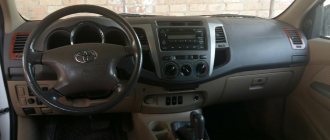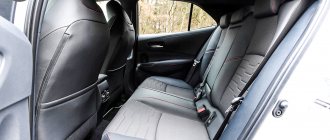Design of Toyota 4 Runner
The Toyota 4Runner is a mid-size SUV produced in 5 generations since 1984 and known domestically as the Hilux Surf. Initially, the car of a classic design was based on the Hilux pickup truck, but over time it evolved into a more civilian compact-mid-size SUV. Sales in Japan were completed in 2009. In Southeast Asia in 2005, the Hilux Surf was replaced by a similar Fortuner model, also on the Hilux platform. Pho Runner is present in the North American market and in some countries in Central and South America.
Fortuner was launched in 2004. It is a mid-size SUV developed for the Asian market and known as SW4 and Hilux SW4. The car is also presented in the markets of Central and South America and in New Zealand. In 2014, car production was launched in Kazakhstan at the Saryarka plant. The second generation was presented in 2015. The car appeared in Russia in 2017.
Driving impressions
While it’s impossible to argue with the fact that the ride is stiff, the SUV’s suspension shouldn’t be considered primitive, especially considering the decent level of comfort and ability to corner. The V6 engine offers 270 horsepower, which handles heavy loads well. The five-speed automatic transmission is a great addition, although the driver will have to put up with the larger appetites of the power unit. Given its weight and height, the 4Runner can't handle tight corners like the Highlander, but the narrow body is easier to maneuver than full-size rivals. Driver dissatisfaction can be caused by a brake pedal that initially feels too soft and, when pressed harder, causes the brakes to apply too quickly.
Interior
All modifications have a 3-row 7-seater interior. For the second generation, we developed our own interior design, different from the Hilux. However, according to reviews from Za Rulem testers, the architecture, dashboard and multimedia system are identical. But for the Fortuner they used the best finishing materials.
Journalists talk about ill-conceived ergonomics in the placement of buttons, but note a large number of containers and cup holders. The second row of seats folds in a 60/40 ratio, the next - equally.
The third row, according to journalists, is cramped.
On the second, boarding of three passengers is made difficult by a large tunnel. The trunk volume is 297 liters, 620 with the third row folded and 1950 with the second row folded.
Specifications
Structurally, the first Fortuner and the fourth Toyota ForRunner are identical: they were created on the same platform and were equipped with a similar list of engines. In subsequent generations, the cars differed technically. Toyota 4Runner N280 was built on the FJ Cruiser platform. The design is close to the platform of the 2-door Prado. The Fortuner continued to use the Hilux platform: the AN150/AN160 is built on the IMV along with the AN120/AN130. At the same time, for the Fortuner it was modified, increasing rigidity by strengthening the attachment points and increasing the thickness.
The Fortuner dimensions are 4.795 m long, 1.855 m wide, 1.835-1.85 m high. The wheelbase is 2.745 m. The curb weight is about 2.1 tons.
On the Russian market, the car is equipped with two engines.
| Engine | Configuration, type | Volume (l) | Power (hp), at rpm | Torque (Nm), at rpm |
| 2TR-FE | R4, gasoline | 2,7 | 166, 5200 | 245, 4000 |
| 1GD-FTV | R4, turbodiesel | 2,8 | 177, 3400 | 450, 2400 |
In other markets, the Fortuner is available in 1GR-FE, 2GD-FTV, 1KD-FTV, 5L-E. For Toyota 4 Runer, 1GR and 2TR are offered.
2TR is equipped with a 5-speed manual transmission and a 6-speed automatic transmission, 1GD is equipped with an automatic transmission only. In the second generation, instead of permanent, part-time all-wheel drive was used. All-wheel drive mode can be activated while driving.
There is an independent double wishbone suspension at the front and a dependent spring suspension at the rear. Ground clearance is 225 mm. All brakes are disc (until 2021, rear drum brakes in the Asian market). Wheels are 17- or 18-inch, depending on the configuration.
You'll like it
89%
car owners will buy this car again!
- 55% Road tests
- 84% Reliability
- 89% Driver satisfaction
If you spend most of your time exploring remote corners of the planet, the 4Runner is great company. The SUV has enough power to tow enough weight, can seat up to seven passengers, and offers a sophisticated all-wheel drive system.
Options and prices
On the Russian market, Fortuner is offered in 5 trim levels:
- Standard. The initial version is equipped with a 2TR with a 5-speed manual transmission. It includes 17-inch steel wheels, front airbags, manual air conditioning and an additional one for the rear rows, mechanical driver's seat adjustments, and a 4-speaker audio system. The cost is 2.172 million rubles.
- Comfort. The car is equipped with the same engine with a 6-speed automatic transmission. It differs from the basic one in alloy wheels, a chrome radiator grille, a rear view camera, roof rails, fog lights, parking sensors, a multimedia system with 6 speakers and a display. In the cabin: multifunction steering wheel, leather trim on the steering wheel and gearbox, heated steering wheel, front seats, bottom of the windshield, color display on the instrument panel, paddle shifters, cooled glove compartment. Safety: side airbags, curtains. Price – 2.533 million rubles.
- Elegance. It is equipped with 1GD with a 6-speed automatic transmission. Additionally, it includes LED headlights with corrector and foglights, climate control with an additional heater, running boards with silver inserts, and cruise control. The price is 2.803 million rubles.
- TRD. This is a stylistic package that includes bumper and radiator grille covers, 18-inch wheels, and nameplates. The rest corresponds to Elegance. Cost – 2.951 million rubles.
- Prestige. In addition to the Elegance, it has leather seat trim, power driver's seat adjustment, keyless entry, engine start button, power tailgate, 18-inch wheels, DAC (downhill assist), all automatic windows, chrome door handles. Price – 3.031 million rubles.
All versions are equipped with ABS with EBD, knee airbags, Follow Me Home function, 360-degree sensors, a cooled glove compartment, automatic windows, a two-way adjustable steering column, and a choice of driving modes.
All trim levels, except the base one, have a rear view camera. The base version has halogen headlights, the others have LED headlights. Electronic assistants: A-TRC (active traction control), HAC (hill assist), TSC (trailer stabilization) systems.
Advantages and disadvantages of Toyota 4Runner: reviews
Owners rate the Fortuner highly. The advantages of the car include:
- permeability;
- reliability;
- economical with 1GD;
- unpretentiousness;
- capacity;
- visibility;
- climate system;
- optics
In the 2021 iSeeCars.com ranking of the most reliable cars in the United States, the Toyota 4Runner took 5th place.
The disadvantages of the Fortuner are:
- high flow rate with 2TR;
- poor interior with cheap materials;
- ergonomic shortcomings;
- inconvenient folding system for the third row of seats;
- trunk space occupied by seats;
- slow heating of the interior;
- thin body panels;
- weak paintwork;
- fragile bumpers;
- insensitive gas pedal.
The body is characterized by thin panels, weak paintwork and fragile bumpers. Users like the look. Reviews about the dynamics with both engines are mixed: some consider it sufficient, given the weight and class of the car, while others find it slow.
Overtaking at high speeds is difficult. The insensitive electronic gas pedal leads to slow operation of the automatic transmission. The automatic transmission withstands off-road use well. Manual transmission significantly reduces consumption. Cross-country ability is at a high level - thanks to all-wheel drive, overhangs and ground clearance. But the inter-wheel lock is missing. Due to the finishing, the interior looks cheap.
The instrument panel is easily scratched when wiped, after which the readings are difficult to see in the sun.
Despite the cheap interior materials, there is no extraneous noise (only in winter when not warmed up). However, the chairs do not recline flat, which is inconvenient for overnight stays. And the raised, folded 3rd row reduces rearward side visibility. There is no underground niche. The Fortuner is comfortable for long journeys. The cost of the car is considered too high, as is the price of options.
Maintenance costs
The Toyota 4Runner is one of the ten most reliable cars in the world, lasting at least 15 years. The Japanese model is equipped with an engine that does not require major repairs for 500 thousand kilometers. An automatic transmission breaks down after about 300 thousand kilometers. All-wheel drive with suspension is also distinguished by its high endurance, which, even with active use in off-road conditions, will require repairs after 200-250 thousand kilometers. According to calculations, the cost of servicing a Japanese SUV, without taking into account the natural depreciation of parts and insurance costs, amounts to about 150 thousand rubles annually, which is quite low for a car of this class.
Operation of Toyota 4 Runner
According to reviews from Za Rulem and Drive.ru testers, the diesel engine has sufficient traction, but is characterized by a high level of noise and vibration. The gasoline engine is much quieter and more comfortable. Its traction is easy to control, but the dynamics are significantly worse. The latter is largely due to the incompatibility of the engine with the automatic transmission. Mechanics corrects the situation: such a car is similar in dynamics to a diesel one, provides even greater traction control, but is characterized by increased fuel consumption on the highway due to short gears.
Off-road, the difference in traction is almost eliminated by the downshift. As a body-on-frame car, the Fortuner is slow and soft, but stable and predictable. The brakes are quite effective. 18-inch wheels make the car excessively rigid. In extreme modes, a difference in behavior appears, depending on the engine: diesel is heavier, so this modification is more prone to understeer.
Both engines are very reliable. The resource of 2TR is more than 400 thousand km. The main problem of a diesel engine is intense wear of camshafts and rockers. In addition, contamination of the MAF sensor is observed due to clogging of the intake tract, which leads to a drop in performance.
Depending on the driving mode, actual fuel consumption is 9-16 liters of gasoline for 2TR and 9-12 liters for diesel. Reviews of 2TR indicate that there is no noticeable difference when operating on 92 and 95 gasoline. For intensive off-road use, the clutch is rather weak. The chassis, including consumables such as stabilizer bushings, is reliable.
Owners have noted cases of knocking in the front suspension on small irregularities.
The solution is to sharpen the metal bushing under the brake pedal by 1 mm in length. A common problem is brake disc runout. It begins to appear after a mileage of about 20 thousand km. Interior heating is improved by installing thermal insulation. In addition, the interior can be easily disassembled for wiring or sound insulation.
“I spent more than 5 thousand dollars in six months to bring it to fruition.” Toyota 4Runner owner's opinion
— I used to drive a Toyota RAV4. This was my first car. I'm interested in astronomy. To travel outside the city with a telescope, you needed an all-terrain vehicle. Hence the choice of model.
Later I began to travel to the Carpathians, not only to look at the stars, but also to ski and hike in the mountains. The RAV4 has a drawback - a weak first gear in the automatic transmission. For city driving this is not a problem, but more serious loads are not for it.
I started thinking about buying something else. I considered the Renault Duster or Nissan Terrano, but didn’t like the dashboard with the squeaking double turn signal. Suzuki Grand Vitara fell into disuse due to its capricious engine, unreliable front gearbox and frequently leaking transmission gaskets.
There is little information about the Hyundai Creta yet, but owners in reviews are already complaining about problems with the clutch. The new Chevrolet Niva frightened us with its short warranty of 2 years or 30 thousand kilometers. I abandoned the idea of taking the UAZ-Patriot after reading the reviews.
The RAV4 2001-2005 with a manual transmission looked like a logical replacement, but the two copies that were inspected were very disappointing with their condition.
At the same time, I had heard a lot about the 4Runner. I was inspired to look at this Toyota by a video that shows a 4Runner driving up a cliff, pulling carriages, and towing a truck behind it.
The car I bought was sold for at least two years, and then was taken off the market. But I still have the seller's contact. I called him and found out that the car was not sold. He said that he would like to look at the car on a lift and, if everything is fine, buy it at the price at which it was sold. The car is 2002 - they asked for $9,500. Compared to the previously inspected RAVs, the inspection of the 4-Runner did not cause the same sharp negativity. I decided to take it.
The previous owner received two sets of tires and rims. All tires were “bald”. I scrapped them, bought all-terrain Hankook Dynapro AT-M RF10 for $443, tire service - another 30.
It was in March. Once I got stuck in the snow on these tires. Trying to get out, the automatic transmission skidded and overheated - the A/T OIL TEMP light came on, the car did not develop speed and did not go anywhere else.
I checked it with a scanner and the automatic transmission temperature was 105 degrees. I thought: that’s it, we’ve arrived. But he allowed the box to cool for two hours, after which he returned home safely. I looked at the color of the automatic transmission fluid - orange, good thing it’s not black. I changed the fluid at a Bosch service center, where, in order to remove the pan, they hit it with a hammer and bent the transmission oil dipstick.
For two hours before my eyes they fought with the pallet. And the casket, as it turned out later, was easy to open—you had to unscrew the oil dipstick. In general, Bosch service surprised me with its lack of professionalism. Next time I’ll better change the oil in the automatic transmission myself.
Later I bought Nexen Winguard 235/85 R16 winter tires for $468. I really liked the new tire size - high and narrow, only 3 kilograms heavier, so I decided to switch the summer wheels to it. I’ll look, but after 12 thousand miles I’ve already sold the Hankook along with the spare tire.
The rear axle was humming. I started by replacing all transmission fluids: I filled the transfer case and front gearbox with Castrol 75W-90, and Addinol 85W-90 into the rear axle. The bridge did not stop humming.
When driving with rear-wheel drive faster than 60 kilometers per hour, the car swayed; with all-wheel drive, this did not happen until 120. The services said that the “soft” tires were to blame. I also noticed impacts when starting from a stop. During the diagnostics they said that the splined part of the rear cardan was worn out and there was total play in the transmission - shocks were caused by this.
With delivery, the rear universal joint cost $250, but after installation it turned out that it was not the problem! The Prado Club forum suggested that we need to check the silent blocks of the bridge longitudinal rods. And the forum turned out to be right - the silent blocks were indeed to blame for the rocking and shocks when starting off!
I bought CTR lower silent blocks and Jikiu upper ones. There are 8 pieces in total, that's a total of $37. But it was not possible to replace them the first time - the service center could not unscrew the bolts. They offered to cut it out and order new ones. I paid $55 for 8 bolts, nuts and washers, and $150 for the labor.
After replacing the cardan, I went to Ukraine to visit relatives. On the way back, the rear brakes suddenly ran out. The pads were worn out and a terrible squeak appeared. Later it turned out that the adjustable mechanism had broken. At the same time, the bridge was leaking and humming. I didn’t know then that it was worth ordering the entire rear axle assembly with disc brakes from the Land Cruiser Prado. It fits like original and would cost $300-500.
This would have been the best way out of the situation, but without knowing about it, I decided to completely upgrade the brakes. The front discs and pads were taken by Brembo, the rear drums by Dynamax-Korea, and the pads by Raybestos. The total cost is $250. The front four-piston calipers also required rebuilding.
I only dealt with the humming rear axle in June, three months after purchasing the car. The rear gearbox from Hi-Lux Surf cost $245, its delivery cost $20. Mitasu 85W-90 oil cost $27 for 3 liters, the gearbox includes 2.45 liters. We changed the gearbox in the village with friends who repair trucks. They asked only 40 rubles for the work. I was pleasantly surprised at such a low price.
After replacing the gearbox, it turned out that oil was flowing from the bridge through the housing. In the service history from the previous owner I saw the entry “repair of the rear beam (welded leak).” Obviously, we were talking about the rear axle. I decided to make it last a long time and ordered the bridge body from Vladivostok. The case cost 82 dollars, delivery - 20. A garage mechanic replaced the case for 200 rubles.
The previous owner replaced the timing drive 2 years ago. According to the odometer, the car has traveled 30 thousand since then. However, to avoid accidental belt breakage, I replaced the timing drive with a kit. At the same time I changed the attachment belts and the thermostat. Spare parts cost $564, replacement labor in the garage cost 100 rubles.
The 4Runner has a design flaw. It lies in the fact that the lower ball joints are located under the levers, that is, the car seems to hang on the ball joints. Because of this, the wheel can break out, as happens in Zhiguli cars. One of the specialists told me that the design of the front suspension of my car is very similar to the Zhiguli one.
The same problem exists in the Sequoia and Tundra of the same vintage as my 4Runner. The ball joints from the heavier 2001-2003 Sequoia fit my car. I paid $200 for the original balls. At the same time I changed the upper ball joints.
Along with them, I ordered original upper shock absorber cushions, because it is unknown how long they had been driving before me, and original steering tips, because during one “session” of the wheel alignment, something was done incorrectly, and the nut got stuck on the thread of the tip. The cost is the same: 90 dollars for two shock absorber cushions and the same for both original steering tips.
The body-to-frame mounting pads should be changed every 10-15 years. This had not been done before, so the seats were split up. I also ordered the “original” - 10 body cushions with all the bolts and nuts. It cost $500 plus 200 for replacement work with welding.
At one time, the car came from the USA with blown airbags and belt pretensioners. Nobody restored them in Belarus. For $30 in Vladivostok I ordered all 5 belts, including two front ones with intact pretensioners.
Two custom-made airbags from there cost $100, and the left one came with the steering wheel. The belts have already been changed - the job cost $100. The pillows are waiting to be replaced. I checked the errors on belts and airbags with a “pocket” OBD2 scanner. I'm pleased with the result - the errors on the belts have disappeared.
Unfortunately, after 10 thousand kilometers the rear gearbox howled again. I found a gearbox in Nakhodka on the Internet. It was removed from a Hi-Ace minibus with 150,000 miles on it. Cost $150 plus 25 for shipping. Replacement of the gearbox from a garage technician - 120 rubles. This time the oil was filled with Toyota 80W-90 - $32 for three liter cans.
The steering rack was leaking. Based on the experience of other owners, I ordered a SAT rail for $150, because the original rail for $1000 still doesn’t last long. Replacement rack - $60. Maybe I'll get over the old one someday.
Gasoline engine, volume 3.4 liters. Gasoline consumption when driving along the highway in rear-wheel drive at a speed of 90-100 will be 10-11 liters per 100 kilometers. In the city it’s consistently 15. But if you drive around the Carpathians in 2nd-3rd gears, it’s better not to think about fuel consumption at all.
I do not use the gas equipment supplied by the previous owner. There are several reasons. The volume of the trunk is very important to me, and because of the gas cylinder that hung in place of the spare wheel, the “spare” rode in the trunk, which did not suit me. Therefore, the cylinder was abolished altogether, and the “reserve” was returned to its place.
Gas consumption was around 18 liters per “hundred”. Once I refueled with low-quality gas - the engine jerked downhill, which also prompted me to give up gas. I didn't experience any jerking on gasoline.
An engine without hydraulic compensators - it is believed that it is better not to use gas on such engines, because you will have to often adjust the valve clearances. In addition, there was a case when antifreeze began to flow at an incredible rate in the Carpathians. The heating hoses of the gas reducer failed.
A separate story with the spare tire mount. After dismantling the gas cylinder, I discovered that the winch cable was simply cut off! I was lucky enough to find a new winch for $30 in Novosibirsk.
Nothing else to worry about for now. And if it bothers you, in the Far East spare parts are always available and in good condition. A used 5VZ-FE engine is sold for $1000-2000, automatic transmission - 500-1000, transfer case - 500-700. For comparison: the 1GR-FE engine for the next generation is sold used for $6,000.
In addition to troubleshooting, I did some tuning work. Firstly, to increase the ground clearance, I installed spacers in the rear springs: $37 for the spacers, $30 for their installation. The spacers are original Toyota ones. It turned out that such things exist.
Apparently, when installing the spacers at the service station, the wires going to the sensors in the rear axle were torn. ABS, traction control and stability control stopped working. But the new bridge housing came with wires and sensors, so all the problems were eliminated when it was replaced.
There are still air bags from the previous car. They are inflated by hand. With them, the rear of the car handles bumps noticeably smoother and sags less when the trunk is loaded. Installed it myself.
The front part of the car was raised by installing Russian RIF springs with a 2-inch lift and a load increased by 50 kilograms. They cost 67 dollars. The front shock absorbers were supplied with extended self-adjusting KYB Monomax for $187. Labor to replace springs and shock absorbers is $72.
And for $35 they replaced the radio that was left over from the previous car. In the RAV4 it was easy to change it yourself. When selling the car, the buyer refused it as a discount and rented it right in the parking lot near the traffic police. There were difficulties installing the same radio in the 4Runner, so I turned to an electrician for help.
If we take the total, I spent more than $5,000 on finishing it in six months. But what's the big deal here? With the purchase, troubleshooting and tuning, I expected to fit in the money that I would pay for a new Duster. In principle, this is how it happened. And it could have been less if I had not initially used the services of intermediaries, but looked for spare parts myself and bought the entire rear axle, and not individual components.
Listened and recorded by Sergey BOYARSKIKH Photo by Olga-Anna KANASHITS ABW.BY
If you have something to tell us about your car, contact us using the link. Bonus for the story - free car wash with the assistance of the Hawaii car wash complex (Minsk, Dolgobrodskaya St., 16a,)
More than 77,000 offers for the sale of new and used cars in our ad database.











